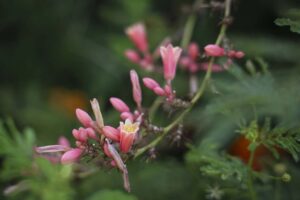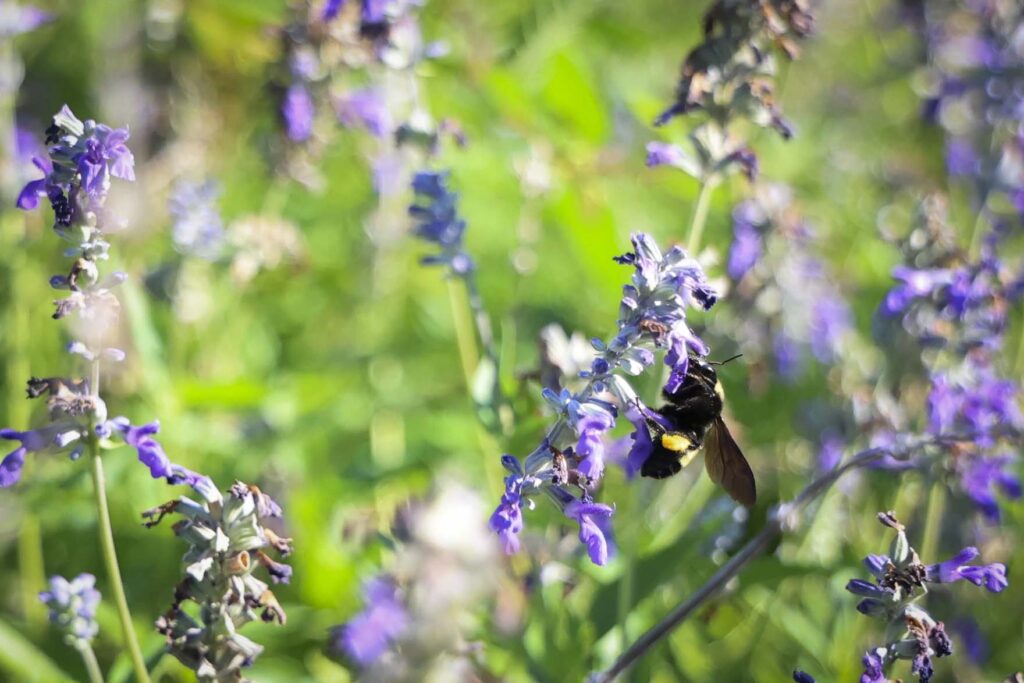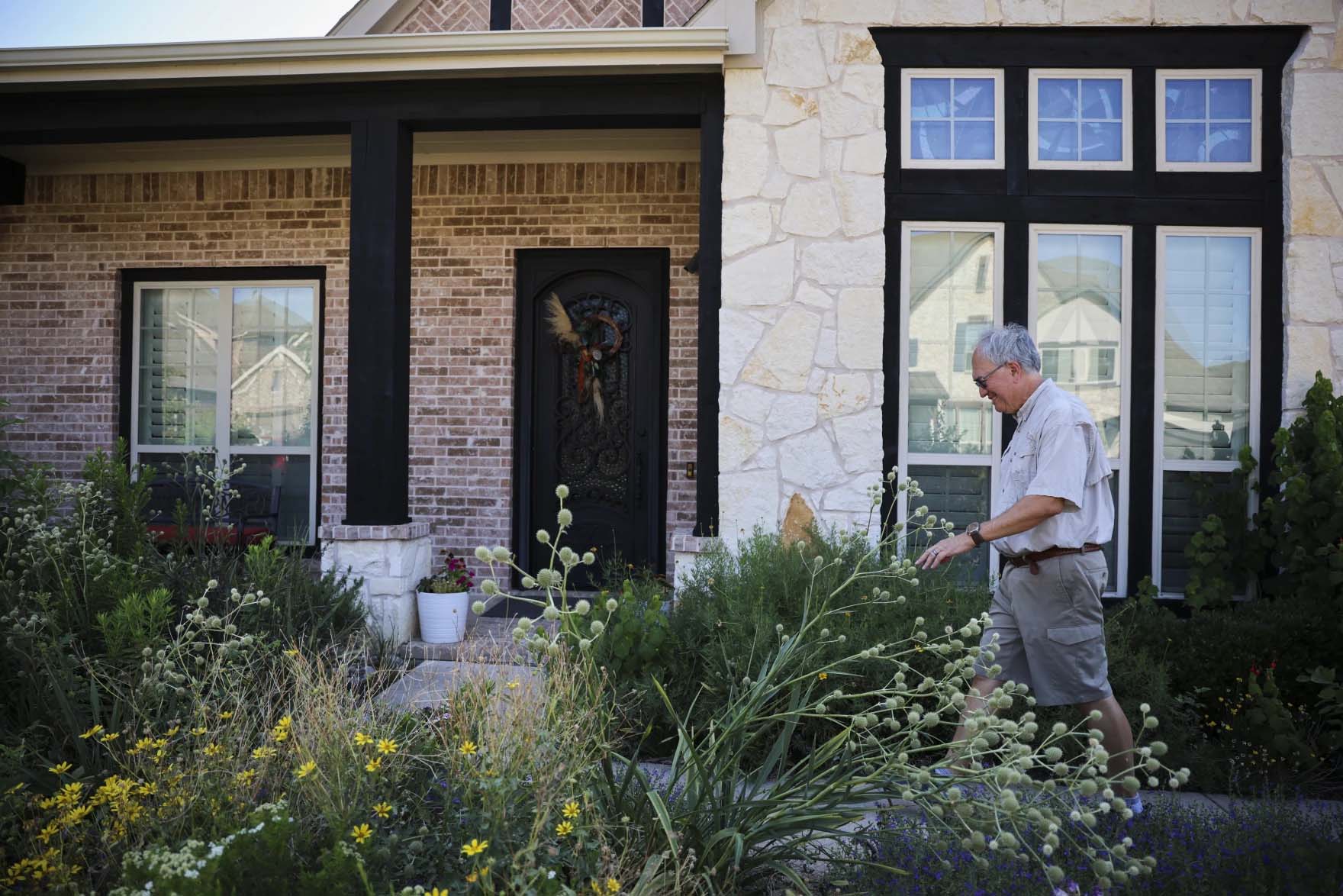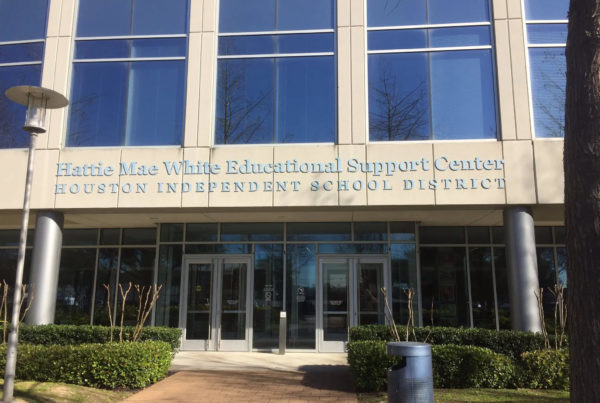From KERA News:
Rodney Thomas’ lush green lawn in McKinney has lots of sounds. There are cicadas, birds — and even bees buzzing about his garden.
One thing you won’t hear is sprinklers. Thomas said he hasn’t turned them on yet.
“We’ve had quite a bit of rain this year,” he said.
But Thomas’ garden is still blooming despite the record heat. He said that’s because he grows native plants adapted to the local ecosystem in much of North Texas — the Blackland Prairie. Thomas is the president of the Collin County chapter of the Native Plant Society of Texas.

A flower blooms in Rodney Thomas’ yard Tuesday, July 25, 2023, in McKinney. Thomas says he rarely waters the native plants that are thriving in the summer heat.
Yfat Yossifor / KERA
The local plants help keep Thomas’ water bill lower than his neighbors. Texas State University hydrogeologist Robert Mace said about a third of Texans’ water usage goes toward irrigating turf.
Suburban life is a drain on water resources. Mace said it takes more water than before to keep lawns green thanks to higher temperatures and drier conditions caused by climate change. He also said households leak 51 gallons of water a day. Then there’s pools — Mace said they increase indoor water usage by 50%. And that doesn’t include the water needed to maintain the pool.
“They’re giant evaporation pans in people’s backyards,” said Mace, who’s also the executive director of the Meadows Center for Water and the Environment.
He said the average person in places like Collin County uses more water than someone in a big city.
“Suburban areas tend to be more affluent than certainly parts of urban areas,” Mace said. “And if you go to the poorer parts of town, you don’t see a whole lot of people irrigating their yards.”
He said that takes a toll on water providers who have to find the resources to meet that need. The North Texas Water Municipal District built the Bois d’Arc Lake reservoir in Fannin County. It started holding water in 2021. The state legislature also passed legislation to fund water projects and improve the state’s water infrastructure.
Mace said Bois d’Arc Lake is a good but temporary solution in the wake of population growth and climate change.
“Maybe all of these water projects are Band-Aids as far as growth is concerned, because we’re just adding more water as we have more growth,” he said.
He said a long term solution would have to address climate change, something that’s not accounted for in Texas’ water plan. Mace said it’s because of political reasons.
The North Texas Municipal Water District told KERA via email that meeting water needs requires flexibility.
“There is no single solution to ensuring reliable water for future generations, nor is there a simple solution,” the email said.
Cities – particularly older ones — also battle with crumbling infrastructure. The Texas Water Development Board estimates that many billion gallons of water soak back into the soil every year because of leaking and broken water pipes.
All of this can have a financial impact on consumers. The cost of water usage may go up soon if the North Texas Municipal Water District raises water rates for several major cities in Collin County to meet the suburban area’s growing demand. The rate increase is expected to go up for member cities to $3.69 per 1,000 gallons of water. That’s 30 cents more than the current rate.
The water district wholesales water to its 13 member cities, which includes Allen, Frisco, McKinney and Plano. The cities then sell the water to their citizens. Most city water rates are at or close to the same rate as what the city pays.
Thomas said there’s a reason plants native to North Texas use less water. He said prairie plants have deeper roots, which means they can survive droughts better than those from tropical regions like Bermuda grass. That’s the grass his homeowners’ association requires. It has to cover 60% of his front yard. The builders put Bermuda grass in his custom home’s backyard, too.

A bee lands on a native plant in Rodney Thomas’ yard Tuesday, July 25, 2023, in McKinney. Thomas says he rarely waters the native plants that are thriving in the summer heat.
Yfat Yossifor / KERA
“I couldn’t close the house without starting it with Bermuda front and back,” Thomas said. “So I end up spending about $12,000 to remove it in the backyard to get it out of here.”
Lawns in Texas drink up even more water in the summer heat — Mace said it’s double what people use in the winter. And thanks to climate change, summer in Texas is getting hotter and longer. There’s also more people who have yards to water in Collin County than years past. The county’s population hit over a million in the most recent census. It’s the third fastest growing county in the nation according to the U.S. Census Bureau.
Most of the increase in water usage in Collin County is caused by that growth. The North Texas Municipal Water District told KERA via email that about 55,000 people move into the district’s service area per year.
Mace said a growing population coupled with climate change puts a strain on water providers – and that drives up costs for consumers.
“The more water we need, the more water we need,” he said. “So we’re going to have to spend more to get that that water.”
People who want to lower their bills and conserve water can plant native plants like Thomas or do something called xeriscaping — it’s a lawn without any grass.
That’s what Marianne Laniphier did to her lawn in Richardson. She recently went to an event at a brewery with the local Democratic Party to learn more about Richardson’s plans to conserve water.
“I have decomposed granite,” Laniphier said. “I have cactus gardens kind of spread throughout the front yard, and in the spring, it’s solid bluebonnets.”
Richardson city council member Ken Hutchenrider spoke at the meeting about how people can use less water. Richardson is one of the member cities of the North Texas Municipal Water District.
Hutchenrider said Richardson’s city council prioritizes low water rates.
“We are pushing as hard as we can to try and get those water rates down,” he said.
The water district board is scheduled to vote on the new rate in late September. It’ll go into effect October 1 if passed.
The projected increase isn’t much. And biology associate professor Rudi Thompson from the University of North Texas said water in the region is still cheap and abundant. But she’s not surprised that people are upset about the rate increase.
“When the cost of stamps go up, we’re all upset, even though that’s pennies on the dollar,” Thompson said.
Thomas said he doesn’t think people will give up their lawns anytime soon.
“The American dream is to have a house with a nice yard around it and picket fence around, kids playing out there, and the dog and cat running around,” he said. “But it’s not reasonable in this day and age. I don’t think it’s something we can continue to do.”













